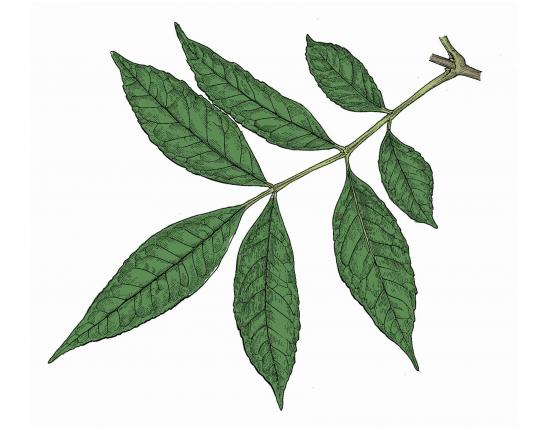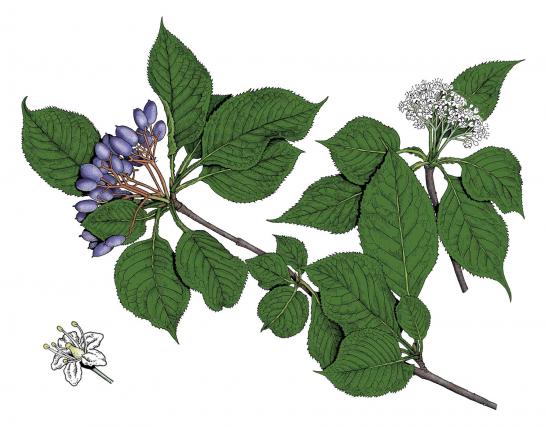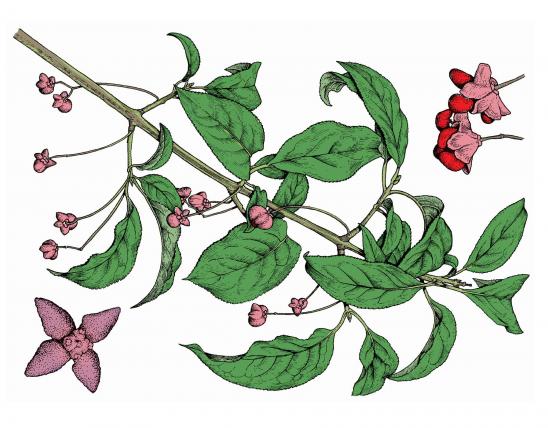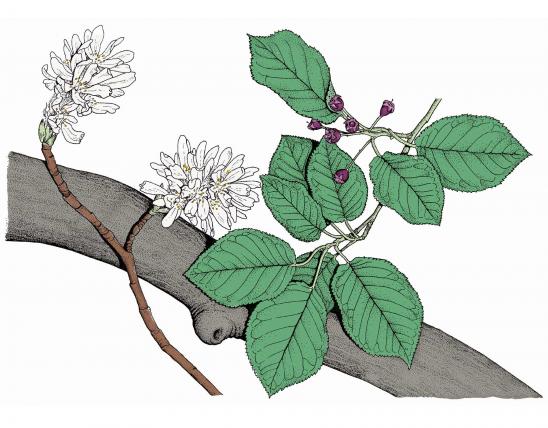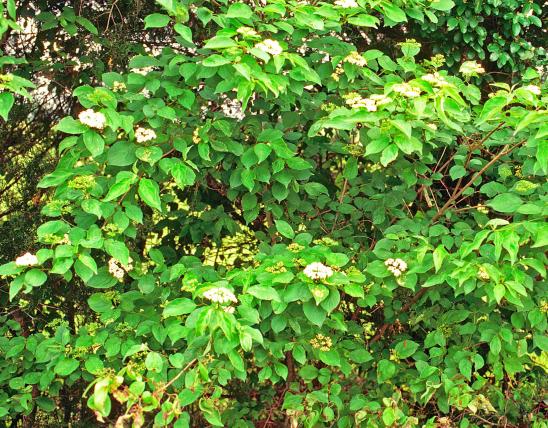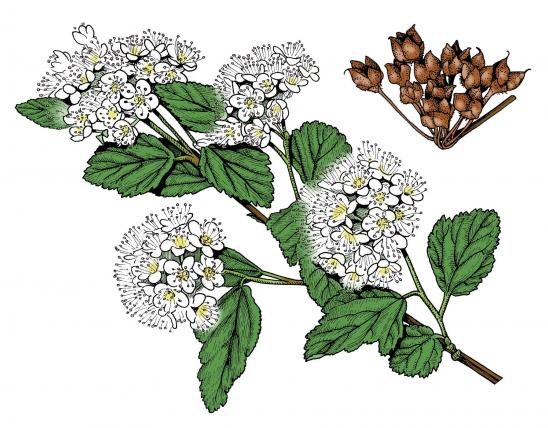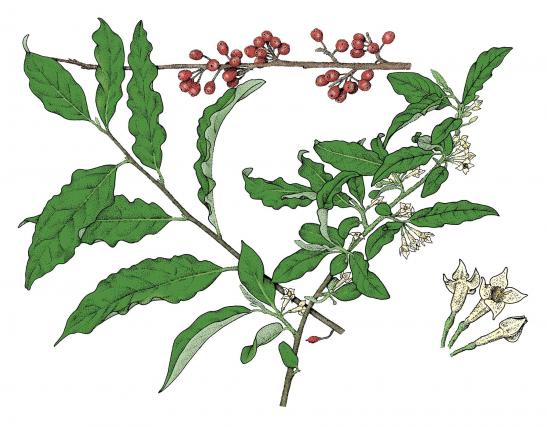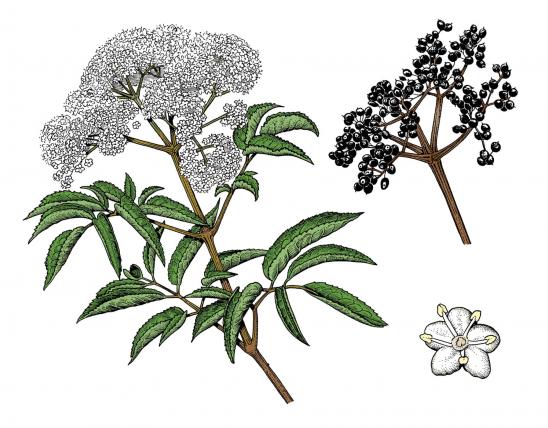
White fringe tree is usually a shrub with crooked branches, but it is sometimes a tree to 33 feet. Usually there are several trunks that spread from the base and ascend toward the tips.
Leaves are simple, opposite, and may appear whorled or clustered near the tip; they are large, 4–8 inches long, 1–4 inches wide, oval to egg-shaped or lance-shaped, with the tip blunt to pointed, the base wedge-shaped, the margin entire or wavy; they are dark green and smooth above, and paler below with hairs on the veins. The leaf stalk is ½–1 inch long, hairy.
Bark is brown to gray, thin, close, flattened, broken into small thin plates, becoming thinly ridged or furrowed with age; the wood is light brown, the sapwood lighter, hard, heavy, close-grained.
Twigs are stout, hairy, light brown to orange, later gray. The leaf scars are raised, and there are raised, oval, darker brown lenticels.
Flowers April–May, in delicate drooping bundles along the twig at the leaf axils, 4–6 inches long; stalks hairy; petal lobes usually 4 (to 6), narrow, the tip pointed, about 1 inch long, white with purple spots near the base, fragrant; stamens 2. Fringe tree is usually dioecious (with male flowers and female flowers on separate plants), but sometimes there are perfect flowers (having functional male and female parts on the same flower) mixed with the male or female ones. The male flowers are showier than the female ones.
Fruits August–October, a drupe (a seed covered by fleshy pulp), borne in clusters, at first olive green, turning bluish black or dark purple, smooth, globe- to egg-shaped, ½–¾ inch long, with 1–3 seeds, each seed about ⅓ inch long, oval, brown. Plants 5–8 years old begin to produce seed.
Similar species: From a distance, American smoke tree (Cotinus obovatus) might be confused with fringe tree. Both are shrubs with simple, alternate leaves crowded toward the branch tips, and both have flower clusters that look something like feather dusters. In smoke tree, the feathery clusters are finer and are actually not flowers — they are the hairy, colorful stalks of the flowers after the blossoms have fallen away. They are in different families. Also, the Eurasian smoke tree (C. coggygria) is a common landscaping shrub that is smaller and has smaller leaves than our native smoke tree; one popular variety has purple leaves.
Height: usually 6–16 feet; occasionally to 33 feet.
Scattered in parts of southwest and southeast Missouri, but may be cultivated statewide.
Habitat and Conservation
Occurs along rocky dolomite wooded ledges and bluffs, and along the edges of dolomite glades in southwestern Missouri. Also occurs along wooded slopes of small creeks and wet bottomland woods in southeastern Missouri. Usually occurs on calcareous substrates.
Status
Native shrub often planted as a showy ornamental.
Fringe tree is in the same family as ash trees, which are killed by the nonnative invasive emerald ash borer (EAB). In 2014, researchers found proof that the EAB can use fringe tree as a host. Apparently, it is not the insect’s first choice, and the EAB seems to attack fringe trees only after most of the ash trees in an area are being attacked and killed, when EAB populations are at their maximum. Initial findings indicate that, except in areas where fringe trees occur in high densities, healthy and unstressed fringe trees can survive the attack.
Human Connections
Fringe tree is becoming increasingly available at nurseries. In full flower, it rivals any native shrub or small tree in beauty, and it tolerates urban conditions well. In late spring, it provides a showy display of fragrant, late spring flowers in drooping fringes. The fruits resemble small olives, at first green but turning black at maturity. It does well in landscaped settings. In autumn, the leaves turn a deep, rich yellow, often with greenish splotches.
You might also see a nonnative relative, Chinese fringe tree (C. retusus), for sale at garden centers. Its leaf bases are different (rounded or heart-shaped, not wedge-shaped), and the petal lobes are shorter.
The genus name, Chionanthus, is from Greek words meaning “snow flower”; virginicus refers to the state of Virginia, probably where it was first found. This plant was first described scientifically in 1753, by Linnaeus himself.
Native Americans, pioneers, and Appalachian folk herbalists used the bark in various preparations to treat a number of maladies, such as skin problems, wounds, fevers, and digestive complaints. Modern herbalists continue to use it today.
Ecosystem Connections
Fringe tree fruit is eaten by several songbirds, including the northern cardinal, American robin, eastern bluebird, blue jay, brown thrasher, and northern mockingbird, and by the pileated woodpecker, wild turkey, northern bobwhite, and white-tailed deer. Deer also browse the leaves.
Bees of various types appear to be the primary pollinators.
Many types of insects make their living from fringe tree, including a variety of scale insects that suck the sap. Moths are another group of insects that feed on fringe tree; among these are the fall webworm and the waved, rustic, and laurel sphinx moths.
One moth that uses fringe tree as a larval host plant is an owlet moth called the fringe-tree sallow (Sympistis chionanthi). Its common and scientific names both reference the fringe tree. The larvae of this moth feed not only on fringe tree but also on ash trees, which are in the same family. With emerald ash borers killing the ash trees on our continent, this moth may ultimately be limited to fringe trees.
Why do we care about the insects associated with native plants? Because plant-eating insects are often limited to eating just one type of plant, or the members of a certain genus or family of plants. The key to these insects’ survival is having their food plants available. Having a rich variety of insects is critical for ecosystems, because many other animals need to eat insects to survive. Birds are a great example, because even birds known for eating fruits or seeds typically switch to an insect-heavy diet during breeding season, when they need the extra protein for their growing young.
Other members of the olive family include ash trees, lilacs, jasmine, privet, forsythia, and, of course, olives.

























